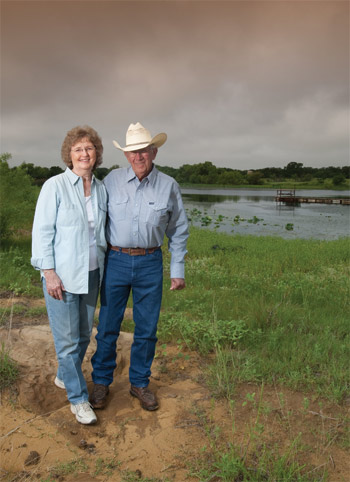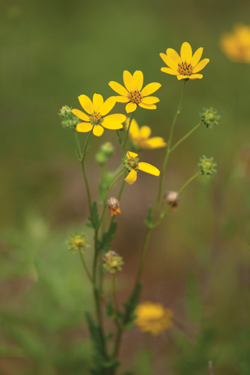
Photos by Russell Graves
Brenda and Donald Boydston
Brenda Boydston glances down the winding red-dirt road of the family ranch and recalls a different time and place — a time nearly four decades ago, when she and her husband, Don, and their children were living in a suburb of Houston, Texas, surrounded by pavement and traffic, far from the rugged beauty of Young County in north Texas.
“I remember when we were still living in the city, Don would call me from work, and he’d always talk about how he’d rather be building fences than working in his office,” Brenda says, as she and Don take a driving tour of the ranch.
In 1973, the couple decided to move their family from Houston back to north Texas where they both were raised. In the process, they traded the security of Don’s job with NASA, where he worked as an engineer on the Apollo program, for the joys of country living.
“It was an easy decision,” Don confides. “We sacrificed a lot to live in the country, like a good job and the security of a steady paycheck, but I’d rather be out on the land and looking after everything here.”
The decision, it turns out, was a good one — good for both the land and for the Boydstons. Since returning to the family ranch near Olney, the couple has devoted themselves to caring for the property and its natural resources. Recently, their conservation efforts were recognized by the Texas Parks and Wildlife Department (TPWD), which presented them with the 2009 Lone Star Land Steward Award for the Cross Timbers and Prairies Ecological Region.
Collaboration With the NRCS
The Boydstons’ careful and deliberate stewardship of the land and its inhabitants is the result of meticulous planning and collaboration with the local USDA Natural Resource Conservation Service and their local lender, Capital Farm Credit in Wichita Falls, Texas.
“We’ve been customers of Capital Farm Credit for about 30 years, with Jim Stewart being our loan officer,” Brenda says. “While we don’t need them as much as we once did, it’s nice to know that we always had someone on our side when we needed help through some tough times.”
Passing over a cattle guard, the Boydstons stop to take a look at a group of first-calf Angus heifers standing belly deep in klein grass. Despite the stress of raising big, healthy calves that are still nursing, the cattle are in excellent condition, and the pasture is lush and green. This is partially the result of 13-plus miles of cross-fencing — which includes fencing off riparian areas to exclude cattle grazing from wildlife-sensitive areas — and a rotational grazing system that takes into account the needs of the livestock, the rangelands and the wildlife.
Working with Wildlife
“When I acquired this place from my parents in the seventies and purchased additional land, we had a lot more mesquite brush than we have today. While quail were a bit more plentiful then, it was rare to see any deer or turkeys,” Don explains, as a male bobwhite scurries along the ranch road.
The Boydston Ranch — more than 3,800 acres in total — lies along a boundary where the mesquite scrub of the Texas Rolling Plains meets the narrow band of oak trees that stretches north to south in Texas like a great hardwood backbone, known as the Cross Timbers region. Don and Brenda recognize the importance of the mast-producing trees like the oaks, and manage their land in a way that provides the maximum benefit to wildlife, while keeping an eye on the economic potential of their grazing lands.
“We sacrificed a lot to live in the country, like a good job and the security of a steady paycheck, but I’d rather be out on the land and looking after everything here.” — Donald Boydston
“In this one place alone, we’ve cleared about a quarter of the land and created a lot of edge habitat for the wildlife. We’ve also planted food plots and firebreaks that provide forage and food-producing plants for birds and deer,” Don says.
Quail, Deer and Turkey Everywhere
As a result of their intensive brush management, which includes controlling invasive species through mechanical and chemical means as well as properly-timed prescribed burns, the Boydstons report a definite bump in their wildlife numbers. Once nearly absent, now staple wildlife species, like deer and turkey, are “everywhere,” and quail numbers hold strong, Don points out. Instead of relying solely on agricultural income, the couple now supplements their ranch income by leasing the hunting rights on a portion of their property.

Engelmann daisy, above, is browsed by cattle and deer on the Boydston Ranch. Birds enjoy the seeds.
Additionally, they’ve built a 12-acre lake to benefit waterfowl and other migratory birds, as well as 12 other ponds for watering livestock and wildlife.
“Don and Brenda’s love of the land is certainly evident,” says Stewart. “Capital Farm Credit is very proud of the long-term relationship we have had with them. As lenders, we are lucky to have borrowers like Don and Brenda.”
After more than 35 years of being conservation-minded, the Boydstons still conduct educational tours of their ranch from time to time and show no signs of slowing down. Because of their efforts, they have been recognized with awards from the Texas Association of Soil and Water Conservation Districts as well as with the recent TPWD Lone Star Land Steward Award.
“It is such an honor to be recognized for what we are doing here,” Brenda says, beaming.
“We don’t do it so much for the money as for the love of where we live.
“We just love this place!” she says.
– Russell Graves
Land Steward Awards Recognize Role of Private Landowners
Lone Star Land Steward Awards are presented annually by the Texas Parks and Wildlife Department to recognize and honor private landowners for their accomplishments in habitat management and wildlife conservation. The program is designed to educate landowners and the public and to encourage participation in habitat conservation.
Established by the TPWD 14 years ago, the program recognizes that private landowners are critical to effective habitat management, as more than 90 percent of Texas land is privately owned.
The objectives of the stewardship program are:
- To recognize private landowners for excellence in habitat management and wildlife conservation on their lands
- To publicize the best examples of sound natural resource management practices
- To encourage youth education and participation in promoting responsible habitat management and improved ecosystem health
- To promote long-term conservation of unique natural and cultural resources
- To promote ecosystem awareness and acknowledge the best conservation practices in the state’s 10 ecological regions
- To enhance relationships between private landowners and natural resource agencies
- To show the important role of private landowners in the future of Texas’ natural resources
Texas AgFinance was a co-sponsor of the 2009 Lone Star Land Steward Program.